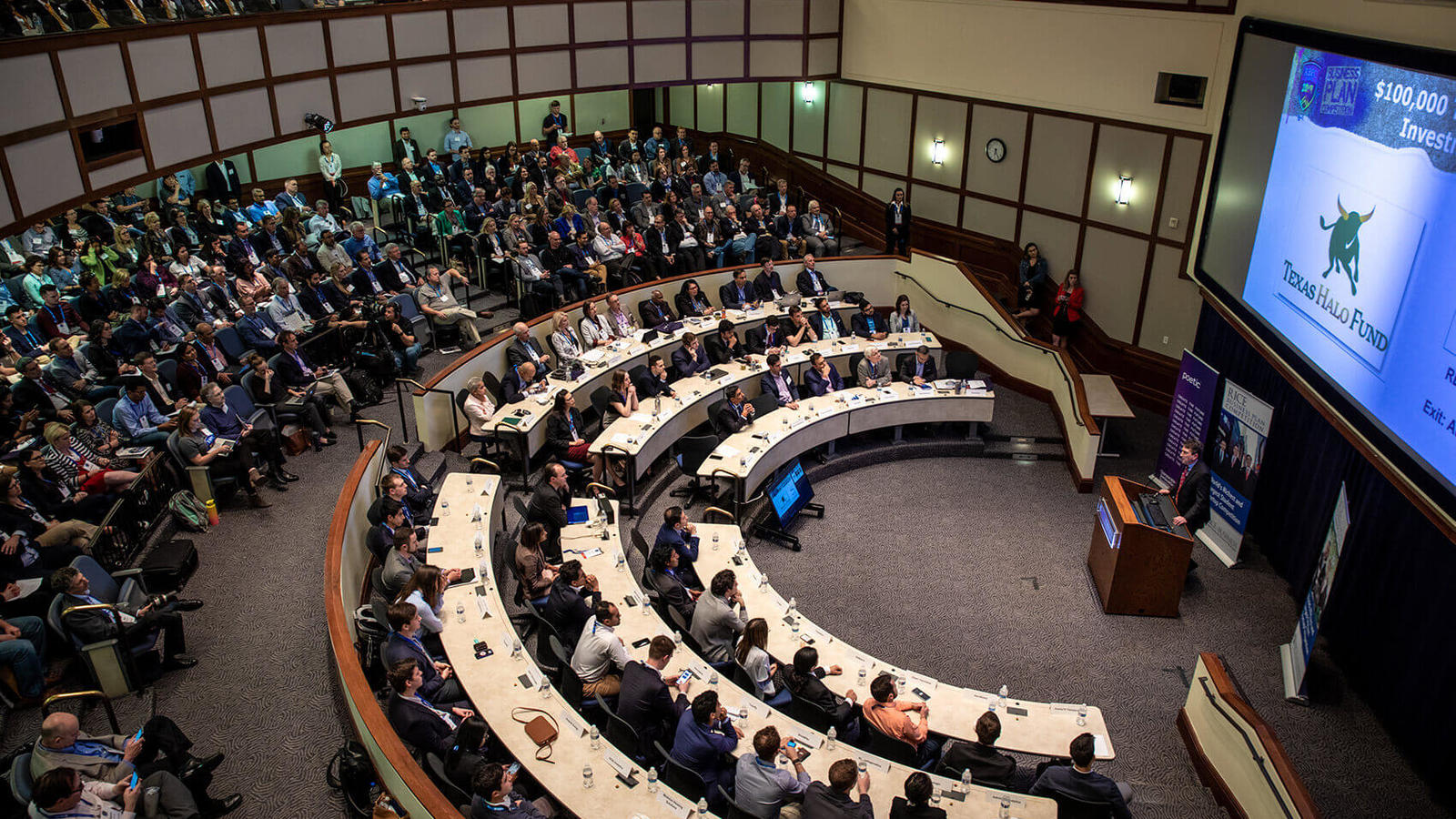Christine Dobbyn to leave ABC13 KTRK
Dobbyn, who is currently getting a Master of Business Administration from the Jones Graduate School of Business at Rice University, has been juggling school and work since the beginning of the school year.
KTRK's Christine Dobbyn set to sign off on air for last time in April
Houston TV viewers will soon say goodbye to Christine Dobbyn, although it's not farewell. "I love my job but was feeling the need for a new challenge," the ABC 13 reporter told Chron.com. Dobbyn is currently getting a Master of Business Administration from the Jones Graduate School of Business at Rice University. She has been juggling school and work since the beginning of the school year.
Rice’s Jones Graduate School of Business to co-host brand house with Texas Monthly at SXSW
Rice University’s Jones Graduate School of Business, one of the country’s top-ranked business schools, will make its South by Southwest (SXSW) debut during this year’s conference in Austin. Rice Business is partnering with Texas Monthly to co-host a brand house on South Congress Avenue March 11-15. The store, located next to Allens Boots, will be transformed into a retro hotel-like space with special daily programming from the school’s professors and student musicians from Rice’s Shepherd School of Music.

Rice University’s Jones Graduate School of Business, one of the country’s top-ranked business schools, will make its South by Southwest (SXSW) debut during this year’s conference in Austin.
Rice Business is partnering with Texas Monthly to co-host a brand house on South Congress Avenue March 11-15. The store, located next to Allens Boots, will be transformed into a retro hotel-like space with special daily programming from the school’s professors and student musicians from Rice’s Shepherd School of Music. The space will have a concierge, bar and pop-up shopping from Stetson and Lucchese.
Rice Business professors presenting include Anastasiya Zavyalova, who will reveal startling truths about public-facing scandals from the NCAA to the Roman Catholic Church; Erik Dane, who will discuss how epiphanies happen, at work and in our personal lives, and what they tell us about the nature of problem solving; Doug Schuler, who will examine the challenges in social sector collaborations to address food insecurity; and Utpal Dholakia, a marketing expert who encourages people to buy and consume prudently to maximize pleasure.
The school’s dean, Peter Rodriguez, will speak at 2 p.m. March 13 on research into what live performances can tell us about the country’s economic future.
For more insights from and information about Rice Business faculty research, visit the school’s Rice Business Wisdom online ideas magazine at https://business.rice.edu/wisdom.
SXSW is an annual music, film and interactive media gathering that attracts hundreds of thousands of people from around the world to the Texas capital.
Members of the news media with questions about access to SXSW should go to https://www.sxsw.com/press.
Related materials:
Follow Rice Business via Twitter @Rice_Biz.
Follow Rice Business Wisdom via Twitter @RiceBizWisdom.
Follow Rice News and Media Relations via Twitter @RiceUNews.
Corporate recruiters rate the brand value of specific B-schools
When Bloomberg Businessweek cranked out its latest ranking of full-time MBA programs last year, the magazine’s lineup was informed by completed surveys from 3,698 employers who recruit MBA graduates. Typically, Businessweek doesn’t share the full results of those recruiter surveys but today (March 6) released a new set of findings from them. When it came to reputation, Stanford Graduate School of Business came out first, with the University of Washington’s Foster School of Business second, UC-Berkeley’s Haas School of Business third, Georgetown fourth and Rice University fifth.
Stereotypes can shape how far students go in STEM
The extent to which students look racially stereotypical—that is, more or less like members of their racial group—influences how likely they are to persist in a STEM-related field, according to a new study. “I think we live in a presumed meritocracy where people believe what you get on tests and how you do in the classroom is what matters,” says Mikki Hebl, chair of psychological sciences and professor of management at Rice University. “Our research says that your looks do matter and can impact your likelihood to depart or remain in a STEM field. And that is pretty shocking.”
Consumer's Report
How you talk about products you don’t like can speak volumes about who you are and how you see yourself.


Based on research by Vikas Mittal, Yinlong Zhang and Lawrence Feick
How You Talk About Products You Don't Like Can Speak Volumes
- Negative word of mouth can tank a product, even if the criticism is unearned.
- In general, women are less likely than men to share unfavorable feedback far and wide.
- How you see yourself and how much you care about the effect your words have on others plays a big part in how likely you are to spread unfavorable word of mouth.
A new product just came out, backed by a high-voltage marketing strategy. But then something unexpected happened. Perhaps there was a glitch in the first run. Perhaps a competitor ran a negative ad campaign. But for whatever reason, the word on the street is that the product doesn’t live up to expectations. In a few months, negative word of mouth has devastated its chances of success.
How did this happen?
Understanding how word of mouth functions is critical to any firm’s chances of success. If your product is perceived as useful, word of mouth becomes a force multiplier for sales and enhanced reputation. If it’s seen as inferior, word of mouth travels in the opposite direction. But word of mouth isn’t always an accurate representation of a product’s strengths. New research shows that it can say more about the people doing the talking — about how they see themselves, how much they care about the impact of their actions on others, and whether they are male or female.
Rice Business Professor Vikas Mittal, along with Yinlong Zhang at UT San Antonio and Lawrence Feick at the University of Pittsburg, undertook a series of studies to investigate the different ways people spread negative feedback within (and outside of) their social circles, starting with the differences between women and men.
The researchers hypothesized that because women tend to focus on those closest to them, they’d be unlikely to bad-mouth a product to people outside their inner circle. Conversely, the team predicted that men, who tend to be more self-focused, would spread negative word of mouth to anyone who would listen.
Their research provides critical insights into how the grapevine can make or break a product. In three different studies, they discovered that women tended to be more concerned about spreading negative word of mouth if they believed that doing so would negatively affect their image in the eyes of others. The first study revealed that women were indeed less likely to voice their concerns about a product to casual acquaintances than to people they had known for some time. Men, on the other hand, tended to have no problem at all sharing negative feedback with everyone — close friends and casual acquaintances alike.
In the second study, the researchers investigated whether people who were less concerned about how others saw them would be more likely to spread negative word of mouth. Respondents were told first to think about how their actions would affect other people, then to consider only how their actions would affect themselves. The team found that women were much less likely to share unfavorable opinions when the others were casual acquaintances than close friends and relations. This effect was particularly high among women who were concerned about their own image; men, on the other hand, were unaffected by such concerns.
In the final study, the research team looked at how different kinds of self-image impacted people’s tendency to broadcast critical opinions of products. They were curious whether people who saw themselves as independent would be more willing to spread criticism than those who saw themselves as interdependent with others.
The results of this survey were consistent with the previous two: People who considered themselves independent were more likely to spread negative word of mouth to all acquaintances — close or casual — than those who saw themselves as inextricably linked with their communities.
What does this mean for us? If you want honest product reviews — especially critical opinions — check with a diverse group of friends: close and casual, male and female, independent and community-minded.
It’s important to note, however, that the study focused primarily on the likelihood that people would engage in negative word of mouth, not on the specific content of the criticisms they shared. Moreover, the digital age enables people to share their thoughts anonymously, which makes it harder to determine who is behind any critical feedback. And anonymity itself may make both men and women more uninhibited when it comes to talking trash about products — and thereby tanking their chances of success.
Vikas Mittal is the J. Hugh Liedtke Professor of Marketing and Management at the Jones Graduate School of Business at Rice University.
To learn more, please see: Zhang, Y., Feick L., Mittal, V. (2014). How Males and Females Differ in Their Likelihood of Transmitting Negative Word of Mouth. Journal of Consumer Research, 40(6): 1097-1108.
Never Miss A Story
You May Also Like
Keep Exploring
Howard Schultz to discuss leadership, business career at Rice March 6
Howard Schultz, former chairman and CEO of Starbucks, will visit Rice University March 6 for a discussion on leadership and the lessons he has learned over the course of his life and business career. Schultz will also share insights from his biography, “From the Ground Up: A Journey to Reimagine the Promise of America.” The presentation, hosted by Rice’s Jones Graduate School of Business and Baker Institute for Public Policy, is by invitation only.
Howard Schultz, former chairman and CEO of Starbucks, will visit Rice University March 6 for a discussion on leadership and the lessons he has learned over the course of his life and business career. Schultz will also share insights from his biography, “From the Ground Up: A Journey to Reimagine the Promise of America.”

The presentation, hosted by Rice’s Jones Graduate School of Business and Baker Institute for Public Policy, is by invitation only. Members of the news media who want to attend should RSVP to Jeff Falk at jfalk@rice.edu or 713-348-6775.
Who: Howard Schultz, former chairman and CEO of Starbucks, in a discussion with Mark Jones, professor of political science in Rice’s School of Social Sciences and fellow at the Baker Institute and Rice’s Kinder Institute for Urban Research.
When: Wednesday, March 6, 6:30-7:30 p.m.
Where: Rice University, James A. Baker III Hall, Doré Commons, 6100 Main St.
For a map of Rice University’s campus with parking information, go to www.rice.edu/maps. Media should park in the Central Campus Garage (underground).
Follow the Jones Graduate School of Business on Twitter @Rice_Biz.
Follow the Baker Institute via Twitter @BakerInstitute.
Follow Rice News and Media Relations via Twitter @RiceUNews.
Founded in 1993, Rice University’s Baker Institute ranks among the top three university-affiliated think tanks in the world. As a premier nonpartisan think tank, the institute conducts research on domestic and foreign policy issues with the goal of bridging the gap between the theory and practice of public policy. The institute’s strong track record of achievement reflects the work of its endowed fellows, Rice University faculty scholars and staff, coupled with its outreach to the Rice student body through fellow-taught classes — including a public policy course — and student leadership and internship programs. Learn more about the institute at www.bakerinstitute.org or on the institute’s blog, http://blogs.chron.com/bakerblog.
MOOCs struggle to lift rock-bottom completion rates
Much of the early enthusiasm for massive open online courses, or Moocs, focused on how they could disrupt and democratise education — opening elite universities’ courses to the masses. They have long faced one stumbling block, however: barely anyone who starts a Mooc completes it. One trend to address this challenge is caharging for courses that include tutoring or a certificate of completion. Rice University’s Jones Graduate School of Business and 2U, an education technology company, are developing a portfolio of short, online courses for business executives.
Rice Business Plan Competition announces 2019 teams vying for over $1.5M in prizes
Forty-two teams hailing from some of the world’s top universities will vie for more than $1.5 million in prizes at the 19th annual Rice Business Plan Competition (RBPC) April 4-6 at Rice University’s Jones Graduate School of Business. The RBPC is the richest and largest startup business competition in the world.

World’s richest and largest student startup contest now bigger than ever
Forty-two teams hailing from some of the world’s top universities will vie for more than $1.5 million in prizes at the 19th annual Rice Business Plan Competition (RBPC) April 4-6 at Rice University’s Jones Graduate School of Business. The RBPC is the richest and largest startup business competition in the world.
For a fourth year, teams will compete for the People’s Choice Competition, which challenges the spirit of each university. Team members, fellow students, alumni, family and friends can vote for their favorite team via a Facebook survey beginning at noon March 1.
The teams for this year’s competition were chosen from more than 300 applicants to compete in four categories: life sciences/medical devices/digital health; digital/information technology/mobile; energy/clean technology/sustainability; and other innovations/investment opportunity.
Select members of the entrepreneurship and investment community reviewed all applications. At the competition, a cohort of 275 judges will decide which company represents the best investment opportunity.
More than 210 former competitors have successfully launched their ventures and are still in business today, including 25 startups that have been acquired. Past competitors have raised over $2.2 billion in capital and created more than 3,000 new jobs.
“The true measure of success for the Rice Business Plan Competition is the number of teams that launch, raise funding and go on to succeed in their business,” said Brad Burke, managing director of the Rice Alliance for Technology and Entrepreneurship at Rice University, which hosts the event. “The competition has served as the launch pad for a great number of successful entrepreneurial ventures, and the success rate far exceeds the national average.”
Top prizes in 2019 are expected to be similar to last year, including the $350,000 Investment Grand Prize from The GOOSE Society of Texas; the $100,000 OWL Investment Prize; the $100,000 Houston Angel Network (HAN) Investment Prize; the $100,000 TiE Investment Prize; and the $50,000 NASA Space Exploration Innovation Award.
Cisco is again offering the largest cash prize at the competition. The $100,000 Cisco Global Problem Solver prize aims to recognize entrepreneurs who promote and accelerate the adoption of breakthrough technologies, products and services that capture the value of technological innovation to society. Special consideration will be given to businesses that also benefit the environment.
The second-place investment prize has increased to $125,000 in 2019. Finger Interests, Anderson Family Fund and Greg Novak of Novak Druce have contributed to the prize.
New in 2019 are the $100,000 Texas Halo Fund Investment Prize and the $50,000 Pediatric Device Prize supporting the advancement and commercialization of novel pediatric medical devices.
Additional prizes:
- $50,000 NASA Space Exploration Innovation Award
- $25,000 nCourage Courageous Women Entrepreneur Prize
- $25,000 Women’s Health and Wellness Prize awarded by Sandi Heysinger and Dick Williams
- $25,000 Texas Business Hall of Fame Prize
- $25,000 Texas Medical Center Accelerator, TMCx, Prizes, plus a guaranteed spot in their accelerator.
- $20,000 Pearland Economic Development Corporation Prize
- The winner of the grand prize will ring the closing bell at the Nasdaq MarketSite in New York.
The RBPC has a new custom-designed application, judging and scoring system, developed and managed by Poetic, a Houston-based business technology solutions firm.
The competition takes place in McNair Hall, the home of the Jones School, 6100 Main St. The awards banquet will be held at 6 p.m. April 7 at Westin Galleria, 5060 W. Alabama St. The banquet is by invitation only but open to the news media.
2019 Rice Business Plan Competition teams
| Startup name | University |
| EnKoat | Arizona State University |
| Crystal Sonic | Arizona State University |
| Flux Marine | Boston University |
| Formally | Brown University |
| Tarseer | Carnegie Mellon University |
| Delta Band | Carnegie Mellon University |
| Colonai | Columbia University |
| Incite Analytics | Cornell University |
| Neutroelectric | Dartmouth College |
| Chord | Harvard University and MIT |
| Modulus Housing Solutions | IIT Madras (India) |
| Treyetech | Johns Hopkins University |
| Avesta76 | Johns Hopkins University |
| Zilper Trenchless | Massachusetts Institute of Technology |
| AeroShield | Massachusetts Institute of Technology |
| Vita Inclinata Technologies | Mitchell Hamline School of Law |
| BetterLife | Nanyang Technological University (Singapore) |
| Sunthetics | New York University |
| Rhaeos | Northwestern University |
| Odin Technologies | Northwestern University |
| RagnaRock Geo | Norwegian University of Science and Technology (NTNU) |
| Hearth Labs | Princeton University |
| LilySpec | Rice University |
| PL Biosciences | RWTH Aachen University (Germany) |
| NABACO | Texas State University |
| Embryologic | University of California, Irvine |
| MiVUE | UCLA |
| Tutorfly | UCLA |
| Vascugenix | University of Arkansas at Little Rock |
| Respira Labs | University of California, Berkeley |
| AC Biode | University of Cambridge (United Kingdom) |
| Beltech | University of Chicago |
| BrewBike | University of Chicago and Northwestern University |
| Curenav | University of Houston |
| Speeko | University of Iowa |
| Calcium Solutions | University of Michigan |
| Dough | University of Michigan |
| dermadiagnostics | University of Notre Dame |
| Resonado | University of Notre Dame |
| Heart I/O | University of Pittsburgh |
| HRG Infrastructure Monitoring | University of Victoria (Canada) |
| Astrolabe Analytics | University of Washington |
For more information on the 2019 Rice Business Plan Competition or to apply, visit http://rbpc.rice.edu.
Rice Business Plan Competition 2019 finalists announced
The Rice Business Plan Competition, the largest such business plan competition in the world, selected 42 teams to compete in its 19th annual event.


